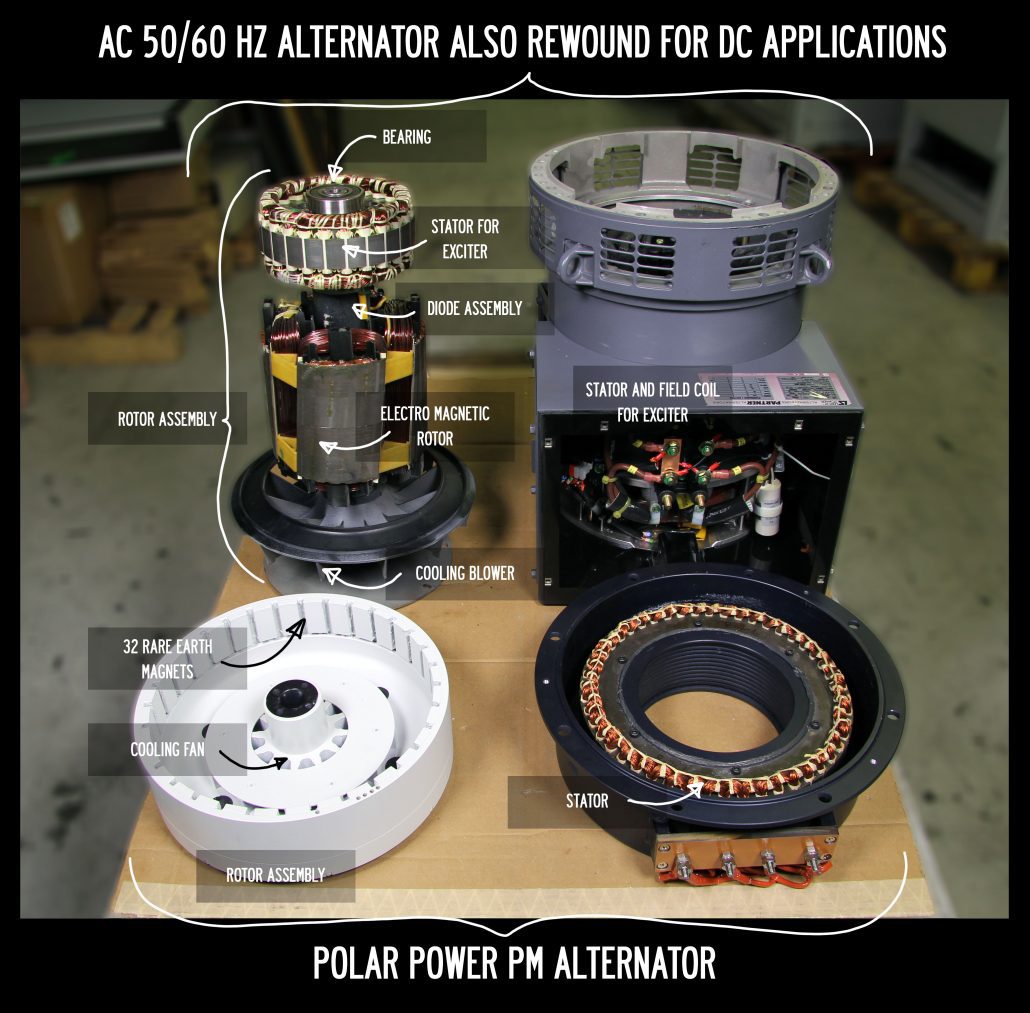 It is easy to argue numbers but difficult to make sense of all of it. This is particularly true if the presenter is arguing “apples with oranges”. The Caterpillar and Cummins White Paper Reports argue in favor of AC generators, but the example(s) used in the comparison of DC generator technology leave Polar’s technology out of the picture. There are many types of AC and DC alternators; the Caterpillar and Cummins White Papers implied that all DC generators use the same technology and have the same efficiency. This is not the case.
It is easy to argue numbers but difficult to make sense of all of it. This is particularly true if the presenter is arguing “apples with oranges”. The Caterpillar and Cummins White Paper Reports argue in favor of AC generators, but the example(s) used in the comparison of DC generator technology leave Polar’s technology out of the picture. There are many types of AC and DC alternators; the Caterpillar and Cummins White Papers implied that all DC generators use the same technology and have the same efficiency. This is not the case.
Polar coined the term DC alternator for a brush-less Permanent Magnet Alternator; our electrical output is a high frequency (400 to 800 Hz), low voltage output optimized for conversion into DC without using a switch mode power supply as illustrated by Caterpillar and Cummins. The high frequency AC current passes through a simple diode bridge circuit then connects to and charges the battery directly, requiring no other electronics.
In Telecom, the term rectifier refers to a battery charger/power supply. In other Engineering Fields, a rectifier refers to a diode. This is where some confusion arises, the Polar DC generator uses a simple diode bridge and few other DC generator systems use a switch mode circuit to regulate voltage and current.
The best fuel efficiency test data is from field trials, not laboratory testing. Typically, laboratory testing fails at simulating real world use of generators as used in their applications. There are too many variables to account for in simulating the real world and at the same time laboratory engineers are always trying to simplify testing parameters. Also, it is unreasonable to compare two manufacturers’ equipment performance by using product data sheets. For an accurate comparison, both tests should use the same test technicians, fuels, weather conditions, loads, test equipment, and operate in actual field conditions.
The purpose of this report is to visually examine the differences in Polar’s technology versus Caterpillar’s Cummins’ and Generac’s technology. For those with some mechanical and electrical backgrounds, common sense will prove the point.
For high energy efficiency electric motors and alternators, most engineers target their design efficiency to be within 90 and 96%. Designers of electromagnetic machinery and power supplies very rarely include the parasitic losses, and marketing never mention them.
 On the right you see a picture; a Leroy Somer Alternator rated at 20 kVA (16 kW), popularly used by Caterpillar and other major AC Generator producers, next to the Polar model 8220 “DC” alternator, rated at 16 to 22 kW (depending on RPM).
On the right you see a picture; a Leroy Somer Alternator rated at 20 kVA (16 kW), popularly used by Caterpillar and other major AC Generator producers, next to the Polar model 8220 “DC” alternator, rated at 16 to 22 kW (depending on RPM).
The differences in technology are readily visible from the photograph.
Both machines are designed for approximately 94% efficiency. The design efficiencies are primarily centered about resistance losses in the stator and do not include all the parasitic losses.
For alternators and motors, parasitic losses include bearing friction, wind friction (windage), excitation, bridge diode, terminal connection resistance, and fan/ blower wheel. The Polar alternator is brush-less and uses 32 rare earth Neodymium Iron Boron magnets to generate a strong magnetic field in the rotor. The 32 poles at 1800 RPM provide 480 Hz input into a simple diode bridge, which transforms it into DC. We vary the engine speed to provide voltage and current regulation. The high frequency allows us to “shrink” the size of the stator. Being able to use rare earth permanent magnets to generate the magnetic field in the rotor simplifies the alternator greatly and reduces its size and weight. The spinning rotor converts the mechanical power from the engine into electricity through the stator.
The parasitic losses in the Polar model 8220 “DC” Alternator are:
• Wind friction (windage)
• Cooling fan
• Voltage drop through the output diode bridge.
• Due to the “pancake” design, a bearing is not required in the Polar Alternator.
The alternator used by Caterpillar or Cummins is brush-less and uses an electromagnet to generate the magnetic field in the rotor. The alternator in the photograph is 4 pole and generates 60 Hz at 1800 RPM. Brushes are not desired in heavy duty alternators because they wear out and require service. This AC Alternator technology does not use permanent magnets. A magnetic field is created by current flowing through windings and steel laminations instead. To transfer power to the electrical windings spinning on rotor (without using brushes and slip rings), a “secondary” alternator of smaller capacity is built onto the shaft of the rotor. As the rotor spins, power is generated for the large 4 pole electromagnet on the shaft. This design feature is referred to as an exciter. The exciter also regulates the voltage to compensate for changing loads. So to make one large alternator work brush-less, you need a smaller, secondary alternator in the circuit to provide DC current to the rotating field coil. The complete exciter circuit has a non-rotating (electromagnetic) field coil in the body of the Alternator; energized by a voltage regulator. This creates a stationary magnetic field. There is a small rotating stator located on the alternator shaft. When this stator spins, an AC current is generated (this process consumes mechanical energy from the engine). The AC current flows through a diode bridge mounted on the rotating shaft and is converted to a DC current. The DC current now energizes the large rotating filed coil which causes the primary magnetic field. The large spinning primary magnetic field converts the mechanical energy from the engine into electricity through the large stationary stator.
The parasitic losses in the typical AC brush-less alternator are from the following:
1. Secondary Alternator Exciter circuit.
• Energy into the voltage regulator to power the exciter stationary field coil.
• Mechanical losses generating electrical power in the exciter stator coil.
• Resistance loss in the winding of the exciter
stator coil.
• Voltage drop in the exciter diode bridge.
2. Primary Alternator:
• Resistance losses in the stator.
• Bearing friction (Polar alternators do not
require a bearing).
• Windage.
• Cooling fan.
Comments:
Engine fuel efficiency is dependent on:
1. Alternator efficiency. From visual observation it is readily apparent that the size of the AC alternator’s blower wheel, the exciter assembly, the rotor’s shape, and presence of a bearing, that friction losses will be considerably higher. The losses in the exciter circuit is relatively large in order to power the large windings in the rotor.
2. Does the alternator and control allow variable speed? AC generators are fixed speed while Polar’s DC generator is variable speed. There should be no argument that reducing engine speed as electrical loads decrease saves fuel. Most programs assume the loads are constant, though in the field, we have rarely seen a constant load or the load match the numbers it was sized for.
3. The engine speed required to drive the alternator. Certain speed ranges offer ideal fuel efficiencies from the engine.
4. Torque ripple on the engine. The four pole alternator creates a large power demand (torque) on the engine, four times per revolution. To provide a stable frequency, the engine’s flywheel has to increase in mass, or a larger displacement engine is selected. Some smaller 2 cylinder engines have both pistons move up and down at the same time (even fire) to drive 50 / 60 Hz Alternators; these engines generate highvibration and noise. Polar’s 32 pole DC alternator has 32 smaller power demands on each revolution; the torque is smaller and more evenly distributed over each engine revolution.
In actual fuel consumption the difference is between 15 to 20% for equal and constant loads.
Fuel savings up to 70% are realized when a Polar DC generator rated at 10 kW – 15 kW replaces a 20 kVA – 40 kVA AC generator. Larger AC generators are used in applications powering smaller loads because the larger AC generators are built to be more robust than smaller standby AC generators. Also AC generators need to be over- sized to handle surge/start up currents from the load.
Polar’s DC Generators do not need to be oversized as the outputs are regulated by both current and voltage. Polar’s small DC Generators are also built to handle prime power applications.
Imagine yourself on a cold night when the starting battery voltage has dropped and the engine oil is thick due to low temperature. Which alternator would you prefer to place on an engine? (Hint the heavier the load the more the starter motor has to overcome).



